| ʿAin Ghazal statues | |
|---|---|
 | |
| Material | plaster and reed |
| Size | 32 items |
| Created | between 7200 BC[1] and 6250 BC [2] |
| Discovered | 1983 ʿAin Ghazal, Amman, Jordan 31°59′17″N 35°58′34″E / 31.988°N 35.976°E |
| Present location | The Jordan Museum |
The ʿAin Ghazal statues are large-scale lime plaster and reed statues discovered at the archaeological site of ʿAin Ghazal in Amman, Jordan, dating back to approximately 9,000 years ago (made between 7200 BC[3] and 6250 BCE),[4] from the Pre-Pottery Neolithic C period.[2] A total of 15 statues and 15 busts were discovered in 1983 and 1985 in two underground caches, created about 200 years apart.[5]
The statues are among the earliest large-scale representations of the human form and represent remarkable specimens of prehistoric art from the Pre-Pottery Neolithic B or C period.[6] Their purpose remains uncertain, with archaeologists believing they may have been buried just after production, having possibly been made with that intent.[7][8]
The ʿAin Ghazal Statues are today part of the collections of The Jordan Museum in Amman, with some also on display at the Amman Citadel's Jordan Archaeological Museum, while a few have been loaned to foreign museums: one statue is in the Louvre Museum in Paris; parts of three other statues can be seen at the British Museum in London;[9] and one of the figures with two heads is on show in the Louvre Abu Dhabi.[10][11]
- ^ Ben-Nissan, Besim (17 April 2014). Advances in Calcium Phosphate Biomaterials. Springer Science & Business. p. 436. ISBN 9783642539800. Retrieved 5 July 2016.
- ^ a b Kleiner, Fred S.; Mamiya, Christin J. (2006). Gardner's Art Through the Ages: The Western Perspective: Volume 1 (Twelfth ed.). Belmont, California: Wadsworth Publishing. p. 25. ISBN 0-495-00479-0. "ca. 6500 6250 BCE".
- ^ Ben-Nissan, Besim (17 April 2014). Advances in Calcium Phosphate Biomaterials. Springer Science & Business. p. 436. ISBN 9783642539800. Retrieved 5 July 2016.
- ^ "Ain Ghazal | Description, Culture, Significance, & Facts | Britannica". www.britannica.com. Retrieved 2021-11-17.
- ^ McCarter, Susan (12 November 2012). Neolithic. Routledge. pp. 161–163. ISBN 9781134220397. Retrieved 20 June 2016. G. O. Rollefson in: Ian Kuijt (ed.), Life in Neolithic Farming Communities: Social Organization, Identity, and Differentiation, Springer (2006), p. 153.
- ^ "Lime Plaster statues". British Museum. Trustees of the British Museum. Archived from the original on 18 October 2015. Retrieved 21 September 2015. The tallest of the Ayn Ghazal statues reach about 1 m in height, and they are assumed to have been free-standing, though anchored in the ground as they could not stand up unsupported. Upper Paleolithic figurines tend to be smaller than 20 cm in height. Taller representations of the human form from the Paleolithic era, such as the Venus of Laussel, are in bas-relief or painted.
- ^ Cite error: The named reference
McCarter163was invoked but never defined (see the help page). - ^ Feldman, Keffie. "Ain-Ghazal (Jordan) Pre-pottery Neolithic B Period pit of lime plaster human figures". Joukowsky Institute, Brown University. Retrieved 16 June 2018.
They are largely held to represent the ancestors of those in the community, or variations on this theme. One can make the argument for this based on the similar treatment of the heads of these statues and the disarticulated and buried plastered skulls. The burial of the statues is also similar to the manner in which the people of Ain Ghazal buried their dead. However, what if these statues are not representations at all, but instead are enlivened objects themselves? What if they were buried in a similar manner to humans because they were thought to have died, or have lost their animate powers? These statues bring up equally many questions as answers, and for this reason will provide a rich site for future study.
- ^ "British Museum, London, United Kingdom — Google Arts & Culture". artsandculture.google.com. Retrieved 2021-09-09.
- ^ Carvalho, Stanley (2017-11-07). "East meets West as Louvre Abu Dhabi opens in the Gulf". Reuters. Retrieved 2019-11-15.
- ^ "The First Villages | Gallery 1". Louvre Abu Dhabi. Retrieved 2021-09-04.

